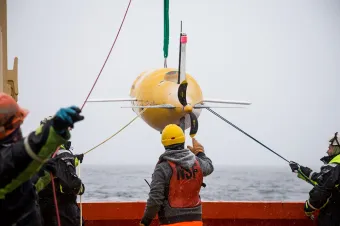
Engineers from the National Oceanography Centre (NOC) are returning from the Thwaites Glacier expedition with renowned autonomous underwater vehicle, Boaty McBoatface.
They deployed Boaty to help them understand what is causing ice loss from the glacier and better predict how its deterioration could contribute to sea level rise.
The NOC provided Boaty McBoatface to the expedition, a state-of-the-art robot submarine that will be a central part of the future net zero oceanographic research infrastructure. The expedition is part of the TARSAN project, a 101-day ship-based expedition that is part of a major global collaboration led by the government science agencies of the UK and USA. Partially funded by 10% for the Ocean through a philanthropy partnership with the NOC, the expedition saw Boaty McBoatface travel over 40km under the shelf measuring currents, turbulence and other properties of the water temperature and salinity.
Ice conditions prevented the team from accessing the Thwaites Ice Shelf during the research mission, which aimed to measure ocean properties into sub-ice shelf cavities using Autonomous Underwater Vehicles (AUV) to detail ocean transports and heat fluxes to better understand the impact of ocean and atmosphere on the ice-sheet change. Due to the unusually thick and dense sea ice around Thwaites, the team carried out their study around the neighbouring Dotson Ice Shelf, with the Nathaniel B Palmer research ship performing a thorough oceanographic survey of the area around the ice shelf.
As part of our commitment to working in partnership, the NOC have been collaborating with the University of East Anglia and the University of Gothenburg. University of East Anglia Seagliders have surveyed the area of open water to the north and across the face, whilst the University of Gothenburg Hugin AUV imaged the underside of the ice with multibeam sonar and retrieved water samples.
Rob Templeton an engineer from the NOC returning from the Antarctic, said: “The team at the NOC has put a lot of work in to minimise the risks of conducting under ice operations into poorly mapped areas over the last 18 months, so we’re pleased to be coming home with Boaty McBoatface, after successfully gathering data more than 40km under the ice shelf. Very little needs to go wrong to transform a deployment from a success to a failure, especially with the fragile glass tipped probe currently fitted to Boaty, so credit to Captain John Souza and the crew of the Nathaniel B Palmer for careful completion of the launch and recovery operations.”
Dr Rob Hall, co-Chief Scientist with the University of East Anglia said “During the cruise we have been undertaking a broad suite of interdisciplinary observations in front of and under Dotson ice Sheet, from microstructure profiler surveys, to trace metal measurements and sediment coring. We have been using the ALR to access the deep-water masses, far under the ice Sheet, to investigate how they are modified by the input of meltwater and turbulent mixing processes.”
Dr Samia Burridge, Head of Philanthropy at the NOC said: “Despite the ocean’s major role in regulating the planet’s climate, it receives just 1% of philanthropy. As an independent charity since 2019, we are joining forces with new partners through the Ocean Alliance. With the support of those who share our passion and values, and through projects like TARSAN that seek a deeper understanding our changing seas, we can all play our part in protecting our ocean and helping the world adapt to change”
Whether your passion is combating climate change, exploring the unknown, protecting ocean life or educating the next generation, supporting the NOC allows you to have a direct impact on world leading ocean research and innovation. To connect with us, contact giving@noc.ac.uk.